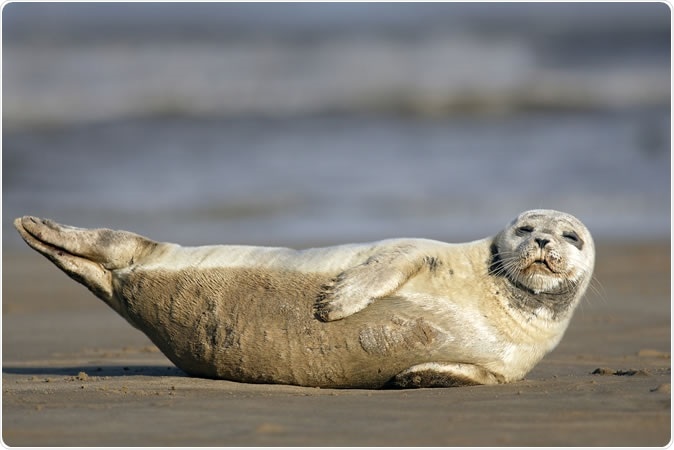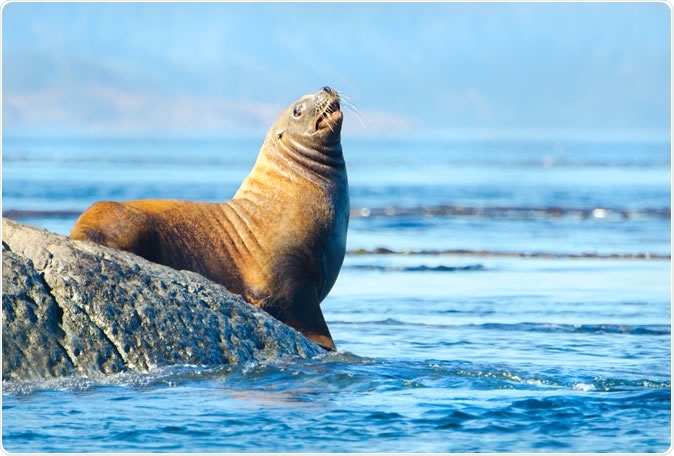A deadly virus that kills thousands of European harbour seals in the northern Atlantic Ocean has now begun affecting seals, otters and sea lions in the northern Pacific Ocean. This virus is called the phocine distemper virus (PDV) that affects animals alone and does not affect humans.

Harbour (Common) Seal (Phoca vitulina) sleeping on the sand, Lincolnshire, England, UK Image Credit: Tony M / Shutterstock
Among animals it is likely to damage nervous and respiratory systems of the marine mammals explain researchers. Now the spread of the virus up north has been speculated to be due to global warming. The study titled, “Viral emergence in marine mammals in the North Pacific may be linked to Arctic sea ice reduction,” was published this week in the journal Scientific Reports.
The team wrote, “Phocine distemper virus (PDV), which has caused extensive mortality in Atlantic seals, was confirmed in sea otters in the North Pacific Ocean in 2004, raising the question of whether reductions in sea ice could increase contact between Arctic and sub-Arctic marine mammals and lead to viral transmission across the Arctic Ocean.”
Tracey Goldstein, associate director of the One Health Institute at the University of California, Davis, School of Veterinary Medicine, was one of the lead researchers of this study. She said in a statement, “How did a virus that had previously been seen in the Atlantic Ocean end up in the Pacific Ocean?” the team looked at 15 years of data from animals that had been tagged by the National Oceanic and Atmospheric Administration as well as from several institutions studying them and their migration patterns.
The team found that the globally warming climate and melting of the arctic ice could be one of the chief contributors to the spread of this infection among the marine mammals. The virus, the team speculates is now capable of moving into a new region and infect sea animals there. Goldstein said, “It was a perfect storm in 2002. It was the lowest ice year on record at the time, and at the same time, in August and September, there was a really large outbreak.”
The team used data from the blood and nasal swab samples from seals, sea lions and otters that naturally inhabited regions or seas between southeast Alaska and Russia. From these samples they identified the viruses that were infecting the animals and also detected the strains of the virus infecting the marine mammals. They wrote, “Samples were collected from 2,530 live and 165 dead ice-associated seals (bearded, ringed, ribbon, and spotted seals), Steller sea lions, northern fur seals, and northern sea otters in the North Pacific Ocean between 2001 and 2016...Sampling locations ranged from Southeast Alaska to Russia along the Aleutian Islands as well as the Bering, Chukchi, and Beaufort Seas.”

Steller Sea Lion. Image Credit: Birdiegal / Shutterstock
Their results revealed that sea ice loss in the arctic regions were directly associated with the outbreaks and rise in the number of cases of the viral infection among the marine mammals. Sea ice reduction in the North Atlantic near Russia was associated with the rise in number of these viral infections in both the oceans say researchers. Goldstein said that melted ice was opening up the water pathways that allowed contact of the infected animals with other species of animals spreading the infection.
First author Elizabeth VanWormer, a postdoctoral researcher at UC Davis during the study and now assistant professor at the University of Nebraska, Lincoln, explained that this virus spreads among the animals as they collect each year during nesting and breeding seasons. At present there is no evidence that the phocine distemper virus is capable of spreading to humans from the animals but the researchers explain the virus is similar to measles virus which affects humans and is very virulent.
The team said, “Peaks of PDV exposure and infection following 2003 may reflect additional viral introductions among the diverse marine mammals in the North Pacific Ocean linked to change in Arctic sea ice extent.”
This is one of the additions to the existing evidence that shows the effect of global warming on animal and human health say the researchers. Warming is also leading to blooming of toxic algae say researchers and these end up killing thousands of marine animals. These toxic algal blooms affect the west coast of the United States say marine zoologists and biologists.
Researchers and other experts have warned that the effect of climate change may be affecting not only marine mammals but also the ecosystems around the world. VanWormer said, “When we see these changes happening in animals, we can’t ignore them, because the impacts on people and the planet are not far behind. This shows how interconnected these things are — the health of people, animals and the planet.”
Journal reference:
VanWormer, E., Mazet, J.A.K., Hall, A. et al. Viral emergence in marine mammals in the North Pacific may be linked to Arctic sea ice reduction. Sci Rep 9, 15569 (2019) doi:10.1038/s41598-019-51699-4, https://www.nature.com/articles/s41598-019-51699-4